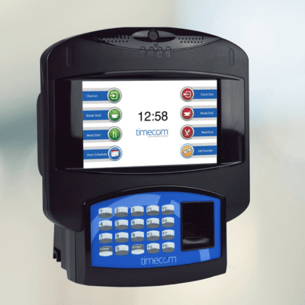Many companies initially turn to mobile or web-based time clock systems in a bid to cut costs. However, they soon discover the significant challenges and unforeseen expenses associated with this form of attendance tracking.
This realization often prompts a shift towards integrating physical time clocks with their existing Oracle Time and Labor software. Regardless of their size, companies find that this integration is a strategic move to maximize the return on their investment and effectively manage attendance tracking.

The Sticky Legal Issues
Using any mobile device burdens the company with a new set of legal and technical risks regarding data privacy and cybersecurity.
Furthermore, each state has its own laws on whether a company can require employees to download a business process application to their personal mobile device. Labor contracts might also include such restrictions.
Some companies avoid these personal device restrictions by providing workers with company-owned mobile devices. However, the other issues remain, only now with the added cost of supplying and managing the devices.
Mobile Apps Undermine Data Accuracy with Oracle Time and Labor
The purpose of bringing on an automated time and attendance system is to reduce labor costs, in part by collecting accurate punches in real time when people are working.
 Allowing workers to use software-based clocks undercuts the goal of data accuracy. A mobile or web-based user experience makes it easy for employees to engage in time theft. No one knows where the worker was at the time of the tap, or even if the person is tapping in or out for themself.
Allowing workers to use software-based clocks undercuts the goal of data accuracy. A mobile or web-based user experience makes it easy for employees to engage in time theft. No one knows where the worker was at the time of the tap, or even if the person is tapping in or out for themself.
The trade-off between convenience for workers and lower initial costs for companies because they aren’t buying time clocks may not be worth it. The costs of overpaying for labor due to time theft and expending resources on identifying and remediating any such misuse may easily exceed any money “saved” not buying physical clocks.
Mobile Devices Aren’t Reliable
When it comes to real-time attendance data integration, relying on employees to always have their mobile devices charged is not a dependable solution.
To address this issue, companies must establish policies and procedures for a parallel track of manual data collection. Additionally, they need to manage Oracle data system to account for missed punches. This is just another way that not using physical time clocks undermines the potential ROI the company can realize from its time and attendance solution.

Mobile Devices are Not Always for Mobile Workforces
For workforces that are mobile, such as field techs or home care attendants, a mobile app is a useful tool. Time tracking via a mobile application integrated with Oracle Time and Labor offers a user interface that can collect their attendance data in real time.
However, it's important for a company not to define “mobile worker” too broadly. Any worker who operates onsite can utilize a reliable time clock installed on the wall. This includes outdoor sites such as construction or agriculture, where a ruggedized time clock can function on battery power and withstand extreme conditions.
Maximize Oracle Time and Labor ROI
Physical time clocks offer a reliable option to ensure full automation and maximum data accuracy for an Oracle integration cloud environment.
Companies that leverage a high-performance Oracle time clock solution can avoid many of the direct and indirect costs associated with relying on mobile for time tracking.
Utilizing physical time clocks does not limit the company to outdated on-premises applications. Modern systems like ATS’s TimeCom provide physical clocks supported by sophisticated cloud services, simplifying data mapping into your Oracle integration.
Contact us today to set up a demo to see how our physical time clocks enhance your Oracle Time and Labor system.





